8 In a Row
The sum of five consecutive integers is equal to the sum of the next three consecutive integers. Can you find the largest of these integers?
Problem
The sum of five consecutive integers is equal to the sum of the next three consecutive integers.
What is the largest of these eight integers?
This problem is taken from the UKMT Mathematical Challenges.
Student Solutions
Answer: 11
Using algebra
Since we are looking for the largest of the eight integers, let the largest one be $n$. Then the others are $n-1$, $n-2$ and so on, and we are given that
$$\begin{align}n+(n-1)+(n-2)&=(n-3)+(n-4) +(n-5)+(n-6)+(n-7)\\
\Rightarrow 3n-1-2&=5n-3-4-5-6-7\\
\Rightarrow 3n-3&=5n-25\\
\Rightarrow3n+22&=5n\\
\Rightarrow 22&=2n\\
\Rightarrow 11&=n\end{align}$$ So the largest number is $11$.
Looking for patterns between choices
Compare starting from 1, 2, ... 8
with starting from 2, 1, ... 9
Image

This will keep happening:
Image

So the largest of the integers is 11.
(Check: 4 + 5 + 6 + 7 + 8 = 30; 9 + 10 + 11 = 30)
Looking for patterns between the numbers
Look at the differences between the last three numbers in the first five, and the second three numbers.
8 is 1 more than 7, 9 is 3 more than 6 and 10 is 5 more than 5.
Sliding the red boxes to the left or right along the number line will change the numbers in the boxes, but not the differences between the numbers.
Image

This means that wherever the red boxes are placed, the difference between the last three numbers in the first five and the second three numbers will always be the same.
That difference will always be 1 + 3 + 5 = 9.
So to balance out the sums, the first two numbers must add up to 9.
Since they are consecutive, they must be 4 and 5. So the numbers are 4, 5, 6, 7, 8 and 9, 10, 11 - and the largest number is 11.
(Check: 4 + 5 + 6 + 7 + 8 = 30; 9 + 10 + 11 = 30)
